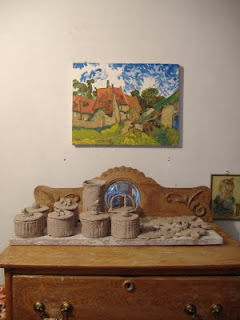
My lecture on Early New England Potters and their pottery was presented at the Harwinton Library on November 18, 2009. I had created a map of all the potters in New England from 1627 to 1900. There were three groups of the earliest settlers on our Northeastern shores. One was a group of German Immigrants landing in Philadelphia and spreading across Pennsylvania. Another was the Dutch landing in New Amsterdam and spreading into New Jersey and up the Hudson. The other group was the English landing near what is now Boston.
The colonies of New England in the 1600s included Connecticut, Rhode Island, New Haven, Plymouth and Massachusetts. New Hampshire and Maine were part of Massachusetts and Vermont was held by New York till 1777. So New York was not considered part of New England even though the borders shifted over the following years.
The first mention of a potter in Salem, Massachusetts in 1629. Rev Higginson wrote in a letter:
“It is thought here is good clay to make bricke, and Tyles and Earthen pots, as need be. At this instant, we are setting a brick-kill on worke to make Brickes and Tyles for the building of our houses.”
Potters were not usually listed as occupations on early census. They usually had other employment, ferrymen, inn keepers or farmers. They passed down their skills to sons, nephews, cousins, brothers and occasionally a wife or daughter. They may have taken on an apprentice who started as a child and did the hard work for five to seven years. Many of the relatives and apprentices moved to other areas to start their own pottery.
Small red ware potteries florished, over 400 potters turned the humble clay into serviceable objects.
One of the local potters in the Northwest corner of CT was Hervey Brooks. Hervey is famous because he kept excellent records. He was a potter in Goshen in the early 1800s and wrote in his journals what pots he made, where he sold them, bricks, trades, working at other jobs and how much supplies cost and sold for. His building was moved to Sturbridge Village in MA. A reconstructed kiln and excellent staff teach people about the potters simple life two hundred years ago.
Hervey was somehow influenced by the Germans in decorating with sliptrailing. Most red ware potters here just used black, green or clear glazes.

In doing the research for this lecture, I came across several receipts for flowerpots my family had purchased in the late 1800s for their florist business in Brooklyn NY. The industrial revolution had a big influence on the small town potteries. With the use of jiggers and jollys, the factories could turn out thousands of identical pots in half the time it would have taken Hervey to throw one.

I have very few original red ware pieces. The above plate by Hervey is privately owned. The shard next to it was given to me by a good friend and it is hard to tell if this is Herveys or one of his predicessors, John Pierce, Jonathon Kettle, John Norton or Jesse Wadhams.
The 3" flower pot to the right was found in my grampas greenhouse. I wonder if it was made by the Hews Company over 100 years ago. The pottery made by two hands squeezing clay as it spins on a wooden wheel like this little flower pot with its lumps and flaws is somehow more appealing than factory made pots of the industrial age.
This is the reason some of us still make things slowly, contemplatively with our hands... it is in the making and the imperfections our hands create that shows a bit of ourselves.
 My lecture on Early New England Potters and their pottery was presented at the Harwinton Library on November 18, 2009. I had created a map of all the potters in New England from 1627 to 1900. There were three groups of the earliest settlers on our Northeastern shores. One was a group of German Immigrants landing in Philadelphia and spreading across Pennsylvania. Another was the Dutch landing in New Amsterdam and spreading into New Jersey and up the Hudson. The other group was the English landing near what is now Boston.
My lecture on Early New England Potters and their pottery was presented at the Harwinton Library on November 18, 2009. I had created a map of all the potters in New England from 1627 to 1900. There were three groups of the earliest settlers on our Northeastern shores. One was a group of German Immigrants landing in Philadelphia and spreading across Pennsylvania. Another was the Dutch landing in New Amsterdam and spreading into New Jersey and up the Hudson. The other group was the English landing near what is now Boston.  I have very few original red ware pieces. The above plate by Hervey is privately owned. The shard next to it was given to me by a good friend and it is hard to tell if this is Herveys or one of his predicessors, John Pierce, Jonathon Kettle, John Norton or Jesse Wadhams.
I have very few original red ware pieces. The above plate by Hervey is privately owned. The shard next to it was given to me by a good friend and it is hard to tell if this is Herveys or one of his predicessors, John Pierce, Jonathon Kettle, John Norton or Jesse Wadhams.







.JPG)
.JPG)
.JPG)
.JPG)


.JPG)


.JPG)
.JPG)


.JPG)



























